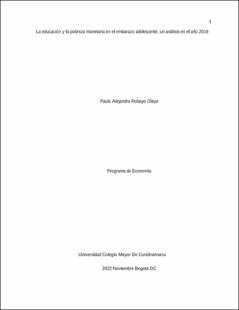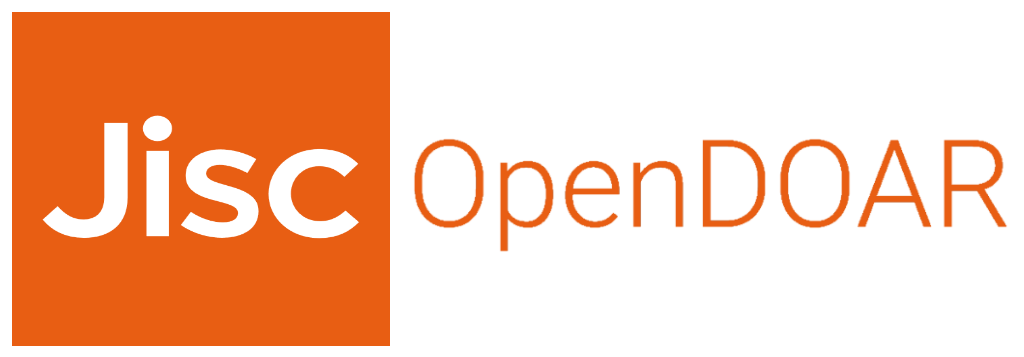La educación y la pobreza monetaria en el embarazo adolescente, un análisis en el año 2019
Trabajo de grado - Pregrado
2022-11
Universidad Colegio Mayor de Cundinamarca
El aumento de los índices de maternidad en adolescentes es el resultado de la deficiencia en algunos aspectos sociales, como la educación, la falta de oportunidades, problemas del entorno familiar, entre otros. Es un tema de gran relevancia puesto que tiene consecuencias económicas y sociales para el desarrollo de un país y para la calidad de vida de sus habitantes. Según Profamilia (2015) Existen diferentes factores que influyen y generan riesgo de embarazo a temprana edad, como lo son: el estrato socioeconómico, las condiciones culturales, el nivel educativo de los padres, las redes sociales, las oportunidades de acceso a diversos derechos sociales y el acceso a la educación. En este trabajo se analiza únicamente dos factores: la pobreza monetaria y la educación. Se busca demostrar que la educación tiene una relación negativa con la fecundidad adolescente, mostrando que ante un aumento en la cantidad de mujeres que se encuentran estudiando la tasa de natalidad adolescente disminuye; por otra parte, la fecundidad está en relación positiva con la pobreza monetaria; esta situación se debe a condiciones culturales y socioeconómicas, lo cual trae como consecuencia una permanencia bajo el umbral de pobreza. El documento finaliza con acciones que permitan mejorar las condiciones de la población, ampliando el acceso a una educación de calidad para así mejorar las condiciones de vida de las madres en el largo plazo, permitiendo tener una mayor posibilidad de ingresar al mercado laboral y mejorar sus vidas, con la posibilidad de salir del umbral de pobreza; por otra parte, se propone poder brindar una adecuada educación sexual con la finalidad orientar a las madres adolescentes para así posteriormente disminuir la fecundidad a temprana edad. The increase in teenage maternity rates is the result of deficiencies in certain social aspects, such as education, lack of opportunities, family environment, etc. It is an issue of great relevance since it has economic and social consequences for the development of a country and for the quality of life of its inhabitants. According to Profamilia (2015) there are different factors that influence and generate risk of pregnancy at an early age, such as: socioeconomic status, cultural conditions, parents' educational level, social networks, opportunities for access to various social rights and access to education.
In this paper, only two factors are analyzed: income poverty and education; due to the fact that, as far as poverty is concerned, Colombia in 2019 ranked second as one of the countries with the highest inequality in the OECD, having a Gini coefficient (measure of inequality) 0. 53 Portfolio (2021). On the other hand, 39% of young people in Colombia were studying, while the remaining 61% were not, Dane (2020), which indicates that more than half of young people do not have access to education. This shows a gap in the education system and in the opportunity of adolescents to access this right.
The study of the variables education and income poverty is relevant because in Colombia there is evidence of difficulties in managing them, which makes it an important factor to study in order to demonstrate that education has a negative relationship with adolescent fertility, showing that, with an increase in the number of women studying, the adolescent birth rate decreases; on the other hand, persons living in a state of income poverty are more likely to have children, where
4
this behaviour may be due to cultural or economic conditions linked to the possibility of having higher incomes in the long term (old age), which means that they remain below the poverty line.
It is therefore important to create measures to improve the conditions of the population by increasing access to quality education in order to improve the living conditions of mothers in the long term, giving them a greater chance of entering the labour market and improving their economic lives, thus enabling them to move out of the poverty line thus subsequently reduce fertility at an early age.
- AAB. Economía [338]
Descripción:
La educación y la pobreza monetaria en el embarazo adolescente (2) (1).pdf
Título: La educación y la pobreza monetaria en el embarazo adolescente (2) (1).pdf
Tamaño: 457.5Kb
 PDF
PDF
 LEER EN FLIP
LEER EN FLIP
Descripción: Robayo Olaya Paula Alejandra.pdf
Título: Robayo Olaya Paula Alejandra.pdf
Tamaño: 146.9Kb
 PDF
PDF
Descripción: FORMATO IDENTIFICACIÓN TRABAJOS DE GRADO .pdf
Título: FORMATO IDENTIFICACIÓN TRABAJOS DE GRADO .pdf
Tamaño: 142.9Kb
 PDF
PDF
Título: La educación y la pobreza monetaria en el embarazo adolescente (2) (1).pdf
Tamaño: 457.5Kb
 PDF
PDF
 LEER EN FLIP
LEER EN FLIP
Descripción: Robayo Olaya Paula Alejandra.pdf
Título: Robayo Olaya Paula Alejandra.pdf
Tamaño: 146.9Kb
 PDF
PDF
Descripción: FORMATO IDENTIFICACIÓN TRABAJOS DE GRADO .pdf
Título: FORMATO IDENTIFICACIÓN TRABAJOS DE GRADO .pdf
Tamaño: 142.9Kb
 PDF
PDF























